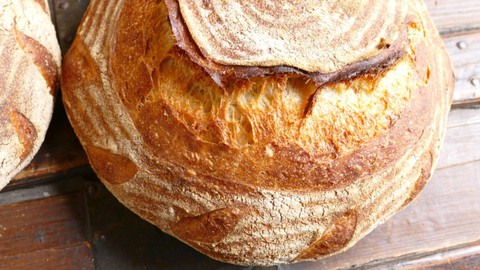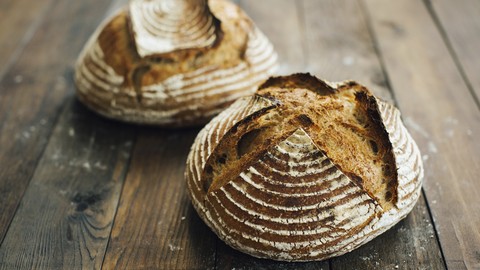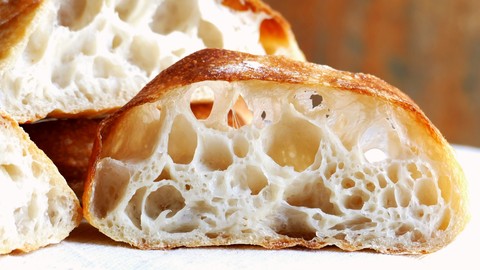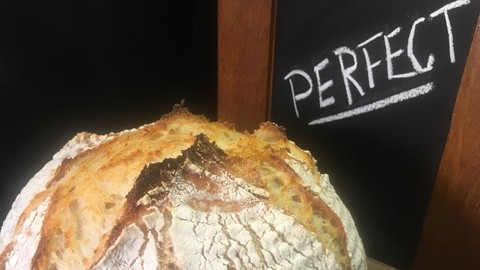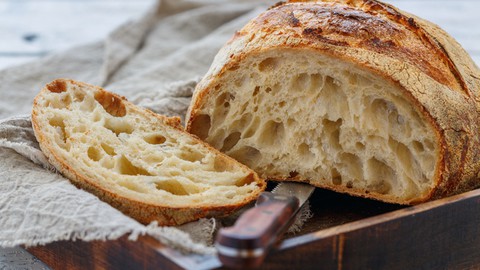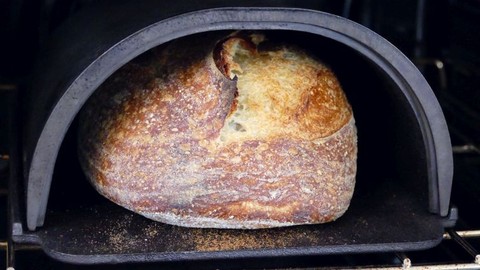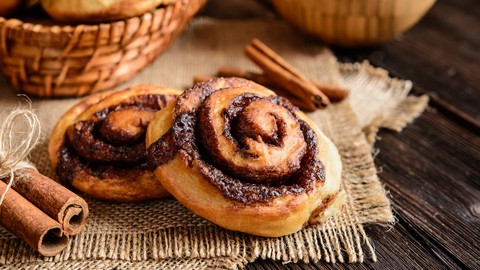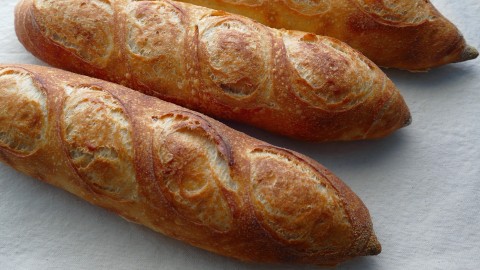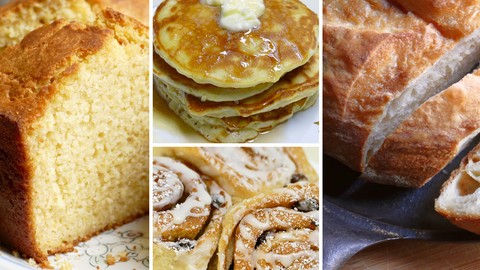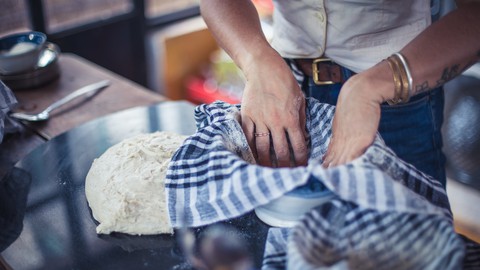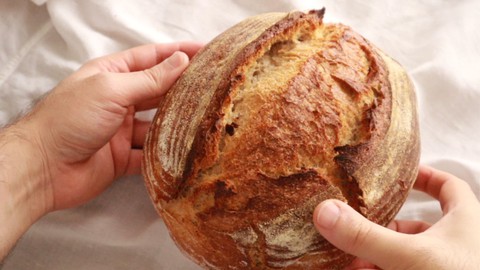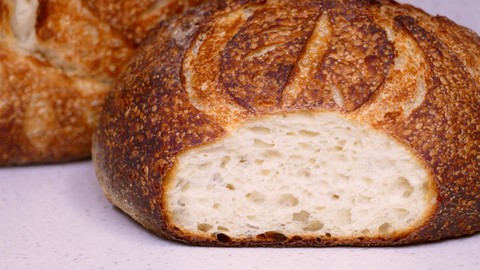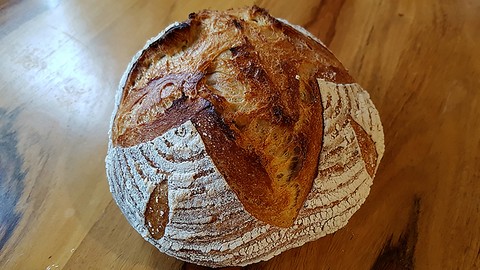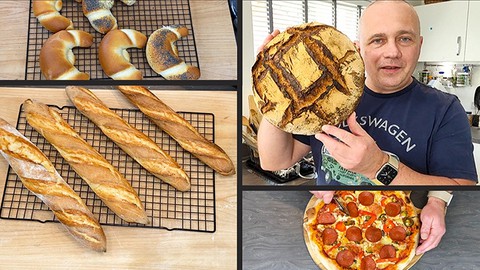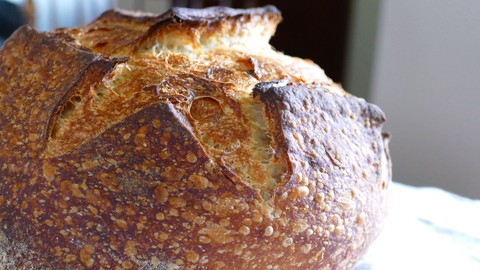What you'll learn
- 🌾 Enhance your baking skills by integrating whole and ancient grains into your bread recipes.
- 🍞 Discover the benefits of long-fermented dough for easier digestion and enriched nutrition.
- 🦖 Create fun and whimsical loaves, like a Stegosaurus-shaped bread!
- 🌿 Explore creative uses for sifted bran and grains left from freshly milled flour.
- 📏 Master the technique of calculating the Desired Dough Temperature (DDT) for perfect baking.
- 🫓 Become proficient in making and utilizing dough binders for your culinary creations.
- 🥖 Learn to craft and manage a low hydration Motherdough, also known as Lievito Madre.
Course Content
Hello and Welcome!
3 lecturesHello and welcome to "More Fun With Sourdough Bread Baking." This is the tenth class in the series of sourdough bread baking courses. In this course we will be using more freshly ground whole grains in our breads. Let's get started!
Most advanced students will have their own sourdough starter already. If you don't, in this lecture you will have some resources to help you make your own starter.
Let's talk about using whole grains and the options you have.
20% or More Whole Grain Bread Formulas
17 lecturesHere's a bit of information on Khorasan wheat and where it came from.
Kamut Sourdough Bread Formula. Khorasan (commonly known as Kamut, which is a trademarked name)Sourdough Bread has 20% by flour weight of freshly ground Khorasan flour. If you don't have access to Khorasan flour, please feel free to substitute any other whole grain flour. I love Khorasan's creamy golden color and wonderful flavor!
This formula has 20% Khorasan (Kamut) in it. Khorasan has a different, more fragile gluten than regular wheat so the dough should be handled with that in mind.
After autolyse, add the salt and start mixing/folding the dough.
Pre-shape the dough and then let it bench rest before final shaping.
Let's finish shaping the dough so we can put it to bed for the night.
The first Khorasan loaf is finished proofing, time to score and bake!
The second Khorasan loaf is now ready to score and bake!
Let's slice into a loaf and see the inside crumb.
This is the formula for July Loaf. July loaf has the fresh whole wheaty flavor and aroma of freshly ground wheat, it is a delightful, flavorful loaf. This is an easy loaf with 22% freshly ground whole wheat flour in the formula. If you keep a whole wheat starter, there would be even more. It is at 70% hydration, but the whole grains soak up a lot of the water so the dough feels drier. If you wish to work with an even higher hydration, check the formula for the variation.
Let's mix up the dough and start the autolyse.
It's time to add the salt and bulk ferment the dough.
Fold the dough to make it strong and develop the gluten.
Pre-shape the dough and bench rest.
Time to final shape the dough and score the first loaf.
The first loaf is baked and the next loaf is scored.
See the finished loaves and let's slice into the bread!
Seeds and Nuts Sourdough
14 lecturesThis is the Formula for Spring Fling Seeded Loaf. This dough has a lot of nice Chia and Flax seeds in it and will make a soft, hearty loaf. The loaf will stay moist for several days because of the seeds.
See how to make up the Spring Fling loaves.
Dough binders are so much fun and so easy! They make the dough spring up higher and so the oven spring is much greater.
Cran-Nut Sourdough is made with over 50% freshly milled whole wheat (mixture of white and red wheat). It is cold proofed overnight and baked the next day. The addition of walnuts and cranberries makes a delicious fragrant loaf great served with cream cheese or toasted with lots of butter. This is not a sweet bread and has no sugar added to the dough other than what is in the dried cranberries.
Grind fresh flour and mix the dough then allow it to autolyse.
It's time to add salt and begin folding the dough to develop strength.
Let's add some cranberries and walnuts and then shape our loaves.
Scoring is always fun. Score the dough and bake the loaf.
My favorite part, let's slice into the loaf and see what it looks like inside!
Seeded Khorasan Sourdough Batards have 31% by flour weight of freshly ground Khorasan (Kamut) flour. If you don't have access to Kamut/Khorasan flour, please feel free to substitute any other whole grain flour. I love Kamut's creamy golden color and wonderful flavor! This formula is a variation of the Khorasan Sourdough Boules earlier in the course but it has seeds, is a higher hydration and has more whole grain flour in it.
After mixing the dough, you will be making up the seed mixture to allow it to cool during the autolyse period.
Let's shape the dough.
Let's bake our batards, they are done proofing and ready for the oven!
The Khorasan batards are finished and sliced, they look ... and taste great!
Using 50% or More Whole Grains
18 lecturesORSW Organic Red Spring Wheat Bread Formula. In this formula I will be using freshly ground wheat berries which have had 7% of the bran extracted from it or what is called 93% extraction rate. I will be using 50% of this wheat flour and 50% of white bread flour. This is a minimal shaped loaf, much like a Ciabatta. This dough is at 100% hydration.
Let's start making our lovely high hydration bread. Grind your grain and mix the two flours and the water.
After autolyse, mix in your starter and then the salt.
See how the dough looks and feels during folding.
It's time to shape our loaves. They are roughed shaped and there is no rounding of corners.
In this video see how to bake up these rustic Ciabatta type loaves.
Time to bake the second batch and slice the loaves... wait until you see inside the loaf!
This is a quick look at a second batch of the same bread I baked up.
How did the Miche become world famous? Did you know Miche means large country loaf?
This formula is a one day Miche with a pre-ferment. It is around 70% (or more) whole grains depending upon your starter and pre-ferment choices. This Miche is just a little over 1 kilo after being baked. There is a variation that will give you two loaves and a higher percentage of whole grains at around 80% of total flour weight.
With this Miche bread formula, we will be making a pre-ferment first. Have your 100% hydration starter fed the night before. We will be making the pre-ferment first thing in the morning. You will also learn how to figure out the DDT which is the desired dough temperature. It's only an option for the home baker and not really necessary, but fun to know how to do.
Once the pre-ferment is almost done fermenting, the whole grain flours are mixed and autolysed for an hour or more. This helps give the flour time to absorb the water, soften the bran and bond the gluten.
Once the pre-ferment and autolysed flours are ready, it's time to combine the two into one dough.
In this video we will fold the dough as it develops during bulk ferment. Folding the dough gives strength to the dough in a gentle manner.
It's time to shape the Miche and we will be shaping a standard boule which is traditional for the Miche.
A Miche is traditionally large, but this particular formula will make a smaller Miche (or a large one, if you double the formula). The scoring will be a traditional diamond pattern. The other famous score (which we don't do) is the "P" for Poilane, the baker who made the Miche famous by his method of making this large loaf.
After a day of fermenting, shaping and proofing our loaf, it's ready to bake.
There's nothing quite so satisfying as slicing into a fresh loaf of bread... except maybe eating it! Let's slice into our loaf and see how the interior looks. A Miche is commonly a fine grained, hearty loaf with a deep colored crust.
Long Fermented Sourdough Breads
17 lecturesRanch Sourdough is formulated to use up some of the coarse bran and grains you may have sitting around after sifting your flour. It is a long fermented sourdough with a moist custardy open crumb and is delicious!
Prepare the grain for the Ranch sourdough formula.
Let's mix up our Ranch sourdough, we'll be using the bran from sifted flour.
Time to add the grains and the salt after autolyse is done.
Folding the dough helps strengthen the gluten and is a gentle way of developing the dough.
Pre-shape a boule and a batard.
Let's do a final shape of our loaves.
Score and bake the batard.
Score and bake the boule.
See the finished Ranch Sourdough loaves and watch me slice them open.
Stegosaurus Bread Formula - Stegosaurus Bread is a room temperature overnight fermented dough. It uses a 22% freshly ground, high extraction wheat flour in the dough, which produces a fragrant delicious loaf. The scoring is lots of fun and will amaze your family and friends.
This bread has a long overnight ferment. Let's get started by grinding some fresh flour and mixing up the dough.
Fold the dough a few times before putting the dough to rest.
Pre-shape the batards and let them bench rest.
After bench rest, shape the final dough and put it in the couche or banneton.
Pre-heat your oven, score and then bake the first loaf of Stegosaurus Bread.
Bake the second loaf the same as the first loaf, then let the loaves cool and slice into them!
Let's Add Some Color!
9 lecturesBeetroot bread is so fun and quite the centerpiece! It looks stunning wherever it goes. It is an unusual bread, is moist, somewhat dense and very flavorful. We will use a low hydration motherdough at 50% hydration which is made the night before.
The beets are peeled, baked and pureed the day before the bake. So prepare them and get them into the refrigerator.
The motherdough is at 50% hydration, you will be using some of the beet juice from the baked beets. Make the motherdough the night before and let is set out at room temperature.
Now add the motherdough, the beet puree, the flour and salt together into a dough.
It's time to bulk ferment and fold the dough for strength and to develop the dough.
It's time to pre-shape the beetroot dough and then we can bench rest it for 20 minutes before final shaping.
The dough is ready to final shape and proof before being baked.
When the dough is finished proofing, it's time to score and bake!
After baking the Beetroot bread, watch as I slice into it's red crumb!
Conclusion
2 lecturesI would like to thank you for taking my course. I hope you've baked up some wonderful breads and had a great time!
Description
Course Updated: May 2022 📅
Explore our comprehensive sourdough baking course designed for passionate bakers. 🌾 In this tenth edition of our pastry course, we've responded to popular demand and incorporated whole grains throughout our recipes. As our courses have grown more advanced, so have our techniques. With this updated course, we dive deeper into the art of baking with whole grain flour blends and sourdough - all naturally leavened with no commercial yeast. 🥖
Featured Loaves:
- Khorasan Boules
- July Loaf
- Spring Fling Seeded Sourdough
- CranNut Sourdough
- Khorasan Batards
- Organic Red Spring Wheat Rustic
- One Day Miche
- Ranch Sourdough
- Stegosaurus Bread
- Beetroot Sourdough Bread
What You Will Learn:
- Mastering the Desired Dough Temperature (DDT) 🌡️
- Grinding and using fresh grains 🌾
- Utilizing leftover bran from sifting flour 🍞
- Incorporating low hydration Motherdough 🥣
- Shaping 100% hydration dough into beautiful forms
- Creating and working with dough binders - lots of fun! 🎉
Important Note: This course is crafted for intermediate to advanced bakers. If you're new to sourdough, please start with our foundational courses.
🔰
What Students Have Said:
"What can I say? Teresa is a teacher who knows how to communicate her passion for sourdough bread. She doesn't just give us recipes. She teaches techniques, shares her knowledge, gives support and tips. This is perfect!" - Julie Fiset✨
"I like to watch the whole process before I start, but it looks like it will be really easy to follow once I dive in. I love Teresa's hands-on method. Being able to see it as it happens is so helpful!" - Karen Yancey👍
"Super easy to follow with combination of written and video instruction." - Meri Issel📚
"I love all of Teresa's courses, including this one. I am able to produce lovely breads, even though I am new to this. I give her courses the credit for this. Her recipes are also outstanding." - Hanle❤️
Join the fun and exploration of sourdough baking with Teresa today! 🎉
Who This Course is For:
- Perfect for those who've completed the first few courses on sourdough baking.
- Serious home or professional bakers eager to advance their sourdough skills.
- Not suitable for beginner bakers - start with Sourdough Bread Baking 101.
Course Reviews
-
😀 Tracy Bowman
-
😀 Cynthia Brubaker
I enjoy learning from Teresa and have had good success with the breads I have tried from her courses on making sourdough bread. I enjoy watching food videos.
-
😀 Nadia Pelayo
-
😀 Angela Steen
-
😀 Peggy Barnes
-
😀 Tammy
-
😀 Di Ajeng Prista Ridlani
-
😀 Atripoli Tripoli
-
😀 Shufreda Cooper
-
😀 Gina Cook
-
😀 Yolanda Nunez
I do love Theresa’s course. I have bought all of them and I’m getting hooked to the process of making sourdough.
-
😀 Detelin Marinov
-
😀 Birgit Mindek
-
😀 Ana Goodwin
Excellent explanation clear, precise and very easy to follow. Teresa is a joy to listen, watch and learn from. Her lock step method makes it very simple to emulate and her clear instructions and explanations about the tasks ensure that bread if carefully prepared as instructed that it will be made successfully.
-
😀 Ginger Rhea
-
😀 Liliana Scurei
-
😀 Theresa C
-
😀 Catherine
Teresa is always such a calm and easy lecturer to follow. Great learning experience.
-
😀 Claudia Jurgensen
-
😀 Rocio Sisa
Sí, buenísima elección.
-
😀 zflari .
-
😀 Sue
-
😀 Feriale
Excellent course. Must
-
😀 Sarit Hadas
-
😀 Cath Sample
-
😀 lori Sidwell
-
😀 Rachel Cohen
-
😀 Mary
-
😀 Margaret Segal
-
😀 Tania Risoleo
-
😀 Sonja Lovas
-
😀 Dawn Lundberg
-
😀 Stella sproat
Love every course I have taken, I’ve learned so much from Teresa , you are so fun to watch and easy to learn from amazing!! Thank you!
-
😀 Renate Danner
-
😀 Margarite
-
😀 Marina Ramya Josef
-
😀 Mayra
awesome!!!!!!!!!!
-
😀 Carey Medin
-
😀 Anita Smith
-
😀 Filippo Giorgetti
si, abbastanza
-
😀 Nancy Passerini
-
😀 Felicia Poon
-
😀 Michelle Mrugacz
-
😀 Naira Kirakosyan
Very interesting course. I learned a lot of new things.
-
😀 Brenda Pfahnl
-
😀 Mandy Davies
-
😀 Jodie Esler
I love Teresa’s courses and she does really interesting breads.
-
😀 Ana Carolina Correa
-
😀 Julie Barneson
Perfect!
-
😀 Elisa H
-
😀 Charlee Funderburg Meche
-
😀 Mon singthin
-
😀 Ann Hung
good recipes, can be faster.
-
😀 Tsahi Atias
-
😀 Jessie Lau
-
😀 Hall Kern
-
😀 Bonnie Graham
Learning about different flours and hydration is new to me and % are still confusing, need to continue on
-
😀 Patsy Keim
Excellent course, I've enjoyed all the variations of sourdough.
-
😀 Sylvia Wright
I don’t know a lot about grains and seed for bread but the course helped me with that! It’s a wonderful array of different breads and I look forward to baking a lot of them! The beet bread was very fun and gorgeous! I love how Teresa never gets anxious handling sticky doughs and makes me feel I can do any kind of dough too. Just breathe and jump right in!! Of course have a gentle hand ????!!
-
😀 Linda Wilhelm
Kinda slow
-
😀 Agnes Chong
-
😀 Irma Bauer-Levesque
Instructions are really clear. I've corrected my work as a result
-
😀 Bassem Hazime
-
😀 Sandy Sarpaş
-
😀 Deb Magee
I love your courses, for future I would love to see more on scoring and also bakers math when you use a preferment and how to figure out the hydration.
-
😀 Irene Bensinger
Teresa is such a wonderful teacher. She helps us believe that we, too, can bake such wonderful bread. And she generously answers all questions along the way.
-
😀 Barbora Gottwaldova
-
😀 Spyridon Katridis
-
😀 Quentin Dishman
-
😀 Sandy Sibert
-
😀 Marie-Louise TANK
-
😀 Andrée Crepeau
Excellant as always
-
😀 Steven Holtzclaw
-
😀 Michaela Vasikova
perfect course!!! I love it.
-
😀 Lubomira
-
😀 Leslie Vary
I enjoyed the challenges in making and baking longer fermented doughs. The use of different flours also created great flavors. Also, since Teresa's fermenting dough temps were usually 70 degrees, and I wanted to imitate that, I had to devise a way to cool ferment my doughs - in an 85 degree kitchen - when the formulas did not call for any refrigeration (even though that option may have been permissible.) I am definitely more confident in my sourdough baking skills.
-
😀 Josef Moshe
-
😀 Tom Gomm
-
😀 Lenie pronk
-
😐 Viven Quek
-
😀 Miriam Haenen
-
😀 Kristi Lambert
Succinct, highly informational, and beautifully filmed
-
😀 Linda Berman
-
😀 Robin Chandler
-
😀 Lottie White
-
😀 Tammie Kruse
I am learning so much, now have many recipes to try. Loving it.
-
😀 Julia Farkas
clear instructions, and i get good results following them
-
😀 Dianne Baker
-
😀 Jolina
-
😀 Kathy DeBernardi
I love the step by step instruction!
-
😀 Catherine Lim
-
😀 Caroline Van Hassel
-
😀 Elizabeth Broudy
Lots of information. Love Teresa.
-
😀 Ruwan colombage
-
😀 Kathleen Morey
-
😀 EJ DESLAURIERS
-
😀 Saskia Pradun-Baur
-
😀 Timothy Brown
-
😀 Charles Shaw
The recipes and tutorials are very good, I just wish there was more of a discussion of why she makes certain choices/uses certain techniques. Some choices are just Teresa's preference, some of them have important reasons. I'd really appreciate that extra level of insight to help me develop my own recipes and techniques.
-
😀 Felicia Tang

